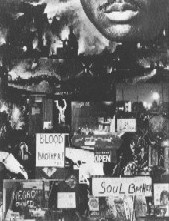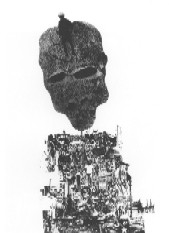| Close Window |
The son of a Sephardic Jew who emigrated to the United States from Russia, Arthur Secunda was aware of religious persecution, social oppression, and economic despair long before the Detroit race riots of 1943. But in 1943, at the formative age of sixteen, he witnessed the eruption of racial hatred and violence firsthand; it was an experience that effected a deep personal commitment to social justice.
Secunda followed the civil rights movement of the 1960s with empathy and growing abhorrence at the escalating violence. In April 1963, Alabama officials arrested Martin Luther King, Jr. after civil rights marches in Birmingham, and in May riots broke out in that city's black neighborhoods. In a powerful painting titled "Birmingham 1963", Secunda expressed his revulsion over the circumstances that precipitated these occurrences.

Then, on August 11, 1965, large-scale rioting broke out in the black neighborhoods of Los Angeles. Characterized as the Watts Riots, this costly conflagration, which left 33 dead, would be followed during the next couple years by similar riots in major and smaller cities all across this country.
Over the next eight years, Secunda captured these events and their underlying causes and meaning in a series of approximately 50 paintings, collages, sculptures and graphics. While the series began with and is named after the riots that broke out in Watts, the body of work captures the wider injustice and despair embodied in the pervasive strife that was sweeping the nation.

The series is in part complex and in part stripped to bare imagery, but both the complex and embryonic elements are incorporated in and emerge from notable, early works such as the 1965 lithograph, "The Looters". Rendered in black and white, "The Looters" incorporates a photo-collage landscape (based on photographs personally taken by the artist), above which rises a black background containing the suspended form of a singular black persona and the resolute lips and jaw of a black face. Below the collage is a strip of whiteness revealing the forms of running figures. (See a photograph of The Looters being printed.)
A number of related sculptural works were constructed of "found objects" from the riot area (essentially artifact-collages), one prominent example being "The City". From a "detached" perspective, "The City" depicts an intricate urban environment; however, an incorporated mirror brings magnified focus to small, component parts. On the first anniversary of the Watts riots, Black artists Noah Purifoy and Judson Powell, with the active involvement of a number of other artists including Secunda, assembled a commemorative exhibition of "found object" sculpture. The exhibition, known as "66 Signs of Neon" (which included Secunda's "The City"), subsequently travelled to numerous art centers and museums nationally.
Each work in this series is strong and compelling, but this is a series where the whole holds even more intense meaning and stronger impact than the sum of its dispersed parts. When these pieces are brought together, subtle contrasts between related works evoke a deeper exploration of meaning and individual expressions thereof than they can evoke separately. As a cohesive series, the dual motifs - collages reflecting pervasive underlying issues, and seminal images embodying personal anguish - are seen to converge and diverge in complementary expression, bringing greater meaning to each individual statement.
Created during the incendiary days of the late sixties and earliest seventies, the Watts Series presents powerful images of their time. While the works depict hopelessness and desperation, disaffection and confrontation, anger and anonymous victimization, they cry out for social justice and human redemption, and, in so doing, embody both hope and optimism. Important reflections of an earlier time, let us hope these works are not prophetic as well.
C. Edward Wall
Ann Arbor, Michigan
March 1992
Source: Exhibition catalog for a retrospective exhibition of works by Arthur Secunda.